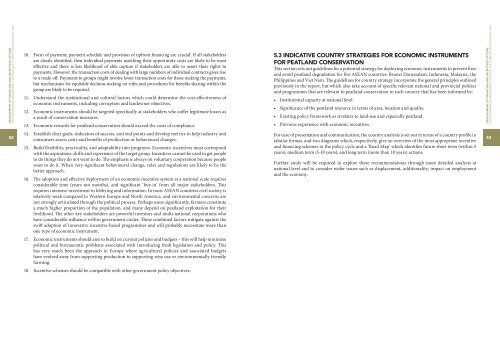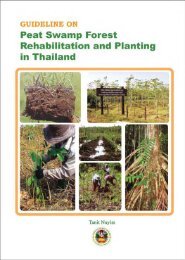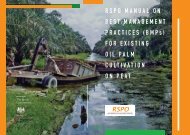DEVELOPMENT OF FINANCING AND INCENTIVES OPTIONSFOR SUSTAINABLE MANAGEMENT OF PEATLAND FORESTS IN SOUTHEAST ASIA50OthERCOMMENTSINCENTIVES atLOCAL levelCRITERIA HAZE FUND REDD+ USER PAYS1 - LOWOnly apply to relativelysmall areas in distinctivelocal context.2 - MODERATECharging systemswill typically work atregional/ provincial/national scales.3 - HIGHHas potential to contributeto the conservation of largeareas of peatland in ASEANcountries.Scale 3 - HIGHHas potential tocontribute to theconservation of largeareas of peatland inASEAN countries.3 - HIGHLocal understanding andrelationships, providingthere are good feedbackmechanisms, shouldtackle drivers effectively.3 - HIGHIf eco-taxes arespecifically targeted atdrivers!2 - MODERATEREDD+ payments are beingdesigned to deal withunderlying socio-economicand cultural drivers butchallenging to addressspecific local concernswithin a global financingmechanism.Drivers 1 - LOWHAZE fund targetedat fire suppression andprevention and maynot address underlyingdrivers.Malaysia, Brunei and toa lesser extent Viet Namhave political buy-in toeco-tourism and hencecould develop a moreregional or even nationalmechanisms based oneco-tourism.User pays stronger innations with strongerregulatory system(Malaysia and VietNam).Indonesia has the biggestpotential due to its widecoverage of peatlands.Haze Fund: Willrequire inter ASEANcooperation to achieveinternational transfer offunds.CountryanalysisStrong political will isrequired.Malaysia and Brunei arein the initial stages ofdeveloping National REDD+strategy, hence it will notbe feasible in short term.REDD+ pilots is possible.Can work in any countryas long as there issource of funding andgovernment support.Clear transparentmechanism, fordeployment of Hazefund, based on clearTOR required.There is potential inIndonesia if peatlandcontinues can gainpolitical attention atthe national level.Voluntary carbon financingis possible for specificsites as pilot studies andopportunities on peatlandsshould be further developed.(e.g. North Selangor <strong>Peat</strong>Swamp Forest).Needs to support fireavoidance as well as firesuppression activities.5.2 SPECIFIC NATIONAL AND REGIONAL CONSIDERATIONSFor the assessment of appropriate economic and financing incentives for Brunei Darussalam, Indonesia,Malaysia, the Philippines and Viet Nam, this section outlines some of the main national and regionalconsiderations for these and other ASEAN countries.1. Economic incentive schemes cannot operate in isolation. Conservation objectives can often be metwhen a range of measures are taken over a period of time. Education and outreach, new regulationsand incentives are all part of the policy tool-box.2. Different incentives systems can be deployed to target different stakeholders - taxation which might beeffective on large corporations investing in palm oil operations, can run alongside livelihood assistanceschemes to promote peatland conservation in local communities.3. Some incentive schemes can be operated at different scales and require different governance mechanismsand institutions. Taxes generally operate at a federal or national level and require direct governmentinvolvement. Eco-tourism on the other hand, operates at the local scale and can be achieved withoutgovernment intervention. Some are multi-scale: REDD+ will require coordination at international,national and local levels to deliver peatland conservation.4. All incentive systems require clarity on the legal status of peatlands. Across Indonesia for example,there are contested claims by the state and local communities over land rights and conflicts are partlythe cause of burning on peatland and encroachment on peatland forests. Resolution of these conflicts isa prerequisite for many incentive schemes and finance options.5. A broad range of agencies and organisations have involvement in, and a degree of responsibility towardsthe sustainable management of peatlands. Effective deployment of economic incentives and financemay require new collaborations between government agencies, NGOs, community-based organisations,and the private sector and will therefore take time. Furthermore, some institutions will require to bestrengthened to play their role effectively.6. A lead organisation needs to be identified. This is crucial, and maybe highly sensitive given the range oforganisations involved. For example, in the case of REDD+ transfer mechanisms should the national orprovincial government take the lead, or should NGOs and private agencies be prominent? Deployment ofeconomic incentives needs careful process management.7. Avoid conflicts of interest. For example, it is assumed that in any form of national REDD+ systemthat the government will play a role in monitoring, accounting for emissions reductions and technicalsupport. However, from an accountability perspective it may be preferable for the government notto be involved in financial transactions as a buyer or seller (i.e. transactions should occur at lowerlevels). To guarantee fairness clear mechanisms for checks and balances from independent thirdparties will therefore be required, whichever institutions are involved.8. Existing institutions may need to be reconstructed to create a cost-effective value chain. For example,a REDD+ value chain will include fund managers for receiving and redistributing funds; registries fortracking emission reduction credits; legal institutions for adjusting existing laws, enforcing REDD+related laws and resolving disputes; monitoring and verification entities for ensuring that emissionsreductions are real and achieved in environmentally and socially acceptable ways; implementing andadministrative organisations for handling contracts and logistics; and the sellers of carbon themselveswho may need to organise internal redistribution mechanisms.9. Learn from existing fund and incentive schemes, and support local ideas and initiatives to ensurethat the ‘top down’ approach meets the ‘bottom-up’ approach.DEVELOPMENT OF FINANCING AND INCENTIVES OPTIONSFOR SUSTAINABLE MANAGEMENT OF PEATLAND FORESTS IN SOUTHEAST ASIA51
DEVELOPMENT OF FINANCING AND INCENTIVES OPTIONSFOR SUSTAINABLE MANAGEMENT OF PEATLAND FORESTS IN SOUTHEAST ASIA10. Form of payment, payment schedule and provision of upfront financing are crucial. If all stakeholdersare clearly identified, then individual payments matching their opportunity costs are likely to be mosteffective and there is less likelihood of elite capture if stakeholders are able to assert their rights topayments. However, the transaction costs of dealing with large numbers of individual contracts gives riseto a trade-off. Payments to groups might involve lower transaction costs for those making the payments,but mechanisms for equitable decision-making on rules and procedures for benefits sharing within thegroup are likely to be required.11. Understand the institutional and cultural factors which could determine the cost-effectiveness ofeconomic instruments, including corruption and landowner objectives.12. Economic instruments should be targeted specifically at stakeholders who suffer legitimate losses asa result of conservation measures.13. Economic rewards for peatland conservation should exceed the costs of compliance.5.3 INDICATIVE COUNTRY STRATEGIES FOR ECONOMIC INSTRUMENTSFOR PEATLAND CONSERVATIONThis section sets out guidelines for a potential strategy for deploying economic instruments to prevent firesand avoid peatland degradation for five ASEAN countries: Brunei Darussalam, Indonesia, Malaysia, thePhilippines and Viet Nam. The guidelines for country strategy incorporate the general principles outlinedpreviously in the report, but which also take account of specific relevant national and provincial policiesand programmes that are relevant to peatland conservation in each country that has been informed by:• Institutional capacity at national level.• Significance of the peatland resource in terms of area, location and quality.• Existing policy framework as it relates to land-use and especially peatland.• Previous experience with economic incentives.DEVELOPMENT OF FINANCING AND INCENTIVES OPTIONSFOR SUSTAINABLE MANAGEMENT OF PEATLAND FORESTS IN SOUTHEAST ASIA5214. Establish clear goals, indicators of success, and end points and develop metrics to help industry andconsumers assess costs and benefits of production or behavioural changes.15. Build flexibility, practicality, and adaptability into programs. Economic incentives must correspondwith the aspirations, skills and experience of the target group. Incentives cannot be used to get peopleto do things they do not want to do. The emphasis is always on voluntary cooperation because peoplewant to do it. When very significant behavioural change, rules and regulations are likely to be thebetter approach.16. The adoption and effective deployment of an economic incentive system at a national scale requiresconsiderable time (years not months), and significant ‘buy-in’ from all major stakeholders. Thisrequires intensive investment in lobbying and information. In most ASEAN countries civil society isrelatively weak compared to Western Europe and North America, and environmental concerns arenot strongly articulated through the political process. Perhaps more significantly, farmers constitutea much higher proportion of the population, and many depend on peatland exploitation for theirlivelihood. The other key stakeholders are powerful investors and multi-national corporations whohave considerable influence within government circles. These combined factors mitigate against theswift adoption of innovative incentive-based programmes and will probably necessitate more thanone type of economic instrument.For ease of presentation and communication, the country analysis is set out in terms of a country profile intabular format, and two diagrams which, respectively, give an overview of the most appropriate incentiveand financing schemes in the policy cycle and a ‘Road Map’ which identifies future short term (within 5years); medium term (5-10 years); and long term (more than 10 years) actions.Further study will be required to explore these recommendations through more detailed analysis atnational level and to consider wider issues such as displacement, additionality, impact on employmentand the economy.5317. Economic instruments should aim to build on current policies and budgets – this will help minimisepolitical and bureaucratic problems associated with introducing fresh legislation and policy. Thishas very much been the approach in Europe where agricultural policies and associated budgetshave evolved away from supporting production to supporting wise use or environmentally friendlyfarming.18. Incentive schemes should be compatible with other government policy objectives.





